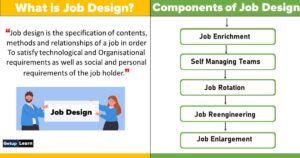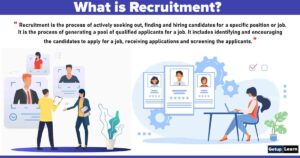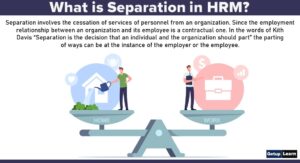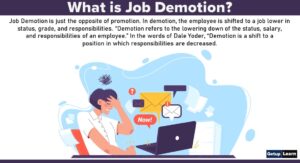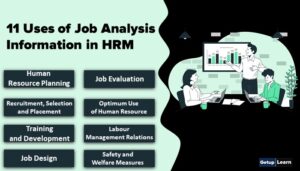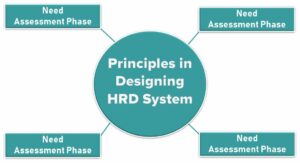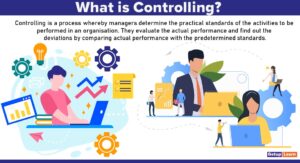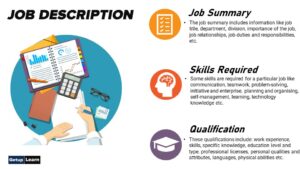Table of Contents
- 1 What is Human Resource Planning?
- 2 Definition of Human Resource Planning
- 3 Need for Human Resource Planning
- 4 Human Resource Planning Process
- 5 Importance of Human Resource Planning
- 6 Advantages of Human Resource Planning
- 7 Limitations of Human Resource Planning
- 8 FAQ Related to Human Resource Planning
What is Human Resource Planning?
Human Resource Planning is the process by which management determines how an organization should move from its current manpower position to its desired manpower position. Through it, the management strives to have the right number and the right kind of people at the right place, at the right time to do things that result in both the organization and the individual receiving the maximum long-range benefit.
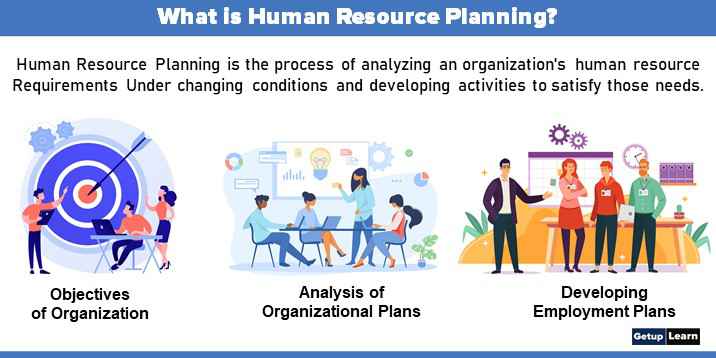
Human resource planning is the process of identifying the correct person for the job that has to be done at the right time and at the right cost. In it, Human Resource Planning tries to estimate the future manpower needs of the organization and includes the strategies that could be adopted by them to meet this requirement.
As the Human Resource Manager estimates the future requirement of human resources, it is the first step in the recruitment and selection procedure. Human Resource Planning is undertaken with three major objectives:
- Attracting, acquiring, developing, and retaining the workforce which is efficient.
- Evaluating employees and setting up an appropriate reward system.
- Optimization of Human Resources cost through effective control of Human Resources plans and programs.
Through Human Resource Planning, the manager estimates the labor force requirement of the organization and what type of skills they should possess. Human Resources managers also scan the labor market to find out whether the workforce with the required skills is available or not. This enables the management to design appropriate policies for attracting, training, and retaining the employees with the required skills.
Human Resource Planning (HRP) plays a vital role in securing an organization’s competitive advantage. By ensuring the right people with necessary and adequate skills are rightly placed at the right time. Retaining employees through strategic policies such as career path planning, pay, and benefits; also engaging in operational strategies, like retraining, redeployment, or relocation in order to make sure employees move in the right perspective by putting in place standards, good reward systems, and employee-employer relationships.
By studying the functions of employees, job analysis tends to gather information on each job and subsequently organize and compile in a job description, which would be used during recruiting qualified job candidates from which selection can be made to occupy the vacancies.
Definition of Human Resource Planning
These are some simple definitions of human resource planning given below:
[su_quote cite=”James W. Walker”]Human Resource Planning is the process of analyzing an organization’s human resource requirements under changing conditions and developing activities to satisfy those needs.[/su_quote]
[su_quote cite=”Dale S. Beach”]Human Resource Planning is a process of determining and assuring that the organization will have an adequate number of qualified persons available at the proper times, performing jobs that meet the needs of the enterprise and provide satisfaction for the individuals in evolved.[/su_quote]
[su_quote cite=”E. Geister”]Human Resource Planning is the process including forecasting, developing, and controlling by which a firm ensures that it has the right number of people and the right kind of people at the right places at the right time doing work for which they are economically most useful.[/su_quote]
[su_quote cite=”Author”]The ongoing process of systematic planning to achieve optimum use of an organization’s most valuable asset is its human resources. The objective of human resource planning is to ensure the best fit between employees and jobs while avoiding manpower shortages or surpluses. The three key elements of the human resource planning process are forecasting labor demand, analyzing present labor supply, and balancing projected labor demand and supply.[/su_quote]
[su_quote cite=”Vetter”]HRP is the process by which management determines how the organization should move from its current manpower position to desired manpower position. Through planning, management strives to have the right time, doing things that result in both the organization and individual receiving maximum long-run benefits.[/su_quote]
Simply Human Resource Planning can be understood as the process of forecasting an organization’s future demands for and supply of the right type of people in the right number. In simple words, HRP is the process of determining manpower needs and formulating plans to meet these needs.
Need for Human Resource Planning
The following are needed for human resource planning:
- Helps in Finding Replacement of Persons
- Reduce Labour Turnover
- Expansion Plans
- Technological Changes
- Assessing Needs
Helps in Finding Replacement of Persons
As a large number of employees are to be replaced in the organization due to reasons such as retirement, old age, death, or any such reasons, a constant need for human resources is required in the organization. Human Resource Planning plays an important role in finding people who can take up vacant positions in a way that the working of the organization is not adversely affected.
Reduce Labour Turnover
One of the problems which an organization has to face includes labor turnover from the organization. But this problem cannot be eliminated. Due to this, an organization is constantly facing the need of recruiting new employees. Human Resource Planning helps the management forecast the labor turnover in an organization which would help them to fill in the vacancies as soon as they arise.
Expansion Plans
Many a time, as an organization is growing, plans are formulated to diversify the business of the organization. Such schemes of the organization require manpower resources as employees would have to take up these new positions which would be created.
Human Resource Planning helps the management to forecast such requirements and find outsources from which these employees can be procured.
Technological Changes
The technology which is used in an organization is ever-changing and it constantly forces the organization to upgrade the skills of the employees of the organization. Moreover, many times, new employees with the required skills might have to be appointed.
In such a situation, Human Resource Planning helps the management in devising the necessary training programs and sources from where the employees with the required skills can be appointed.
Assessing Needs
Human Resource Planning also ensures that the right numbers of employees are available in the organization. In case there is a shortage of workers, then the working of the organization would slow down and it would adversely affect the whole organization.
On the other hand, if the excess number of employees there, then it would lead to an increase in labor cost as the optimum level of work cannot be achieved.
Human Resource Planning Process
The following are the stages of Human Resource Planning:
- Analysis of Plans and Objectives of the Organisation
- Forecasting the Demand of Manpower
- Forecasting the Factors Which Affect the Human Resources Requirements
- Estimating Net Human Resources Requirements
- Developing Employment Plans
- Developing Human Resource Plan
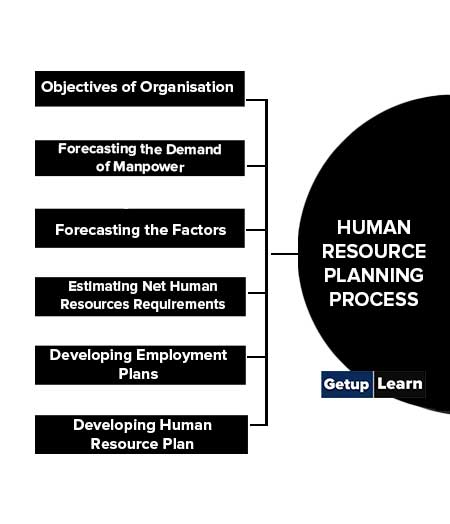
Analysis of Plans and Objectives of the Organisation
Before commencing the activity of Human Resource Planning, the manager should study the short-term and long-term objectives of the organization in detail. This helps the manager to forecast the need for human resources in the organization as well as the skills which should be possessed.
The Human Resource Manager should design the recruitment, selection, training, and union policies that are in line with the objectives of the organization. The Human Resource Manager should ensure that the Human Resource Planning activity should act as a means of increasing the profitability of the organization.
Forecasting the Demand for Manpower
The Human Resource Manager forecasts the demand of the manpower and skills, capabilities, and knowledge required in the future employees of the organization after considering the skills, knowledge, and capabilities of the present employees. The organization may use demand forecasting techniques such as judgmental forecasts or statistical projections for forecasting the requirement of manpower in the organization.
The most commonly used techniques are as under:
Judgmental Techniques
They are conventional methods of forecasting the demand of workers in the organization. These forecasts are based on the judgments of the managers who use their experience for forecasting the number and type of employees required. Judgmental forecasts majorly take two forms:
-
Managerial Estimates: The managers or supervisors who are well acquainted with the workload, efficiency, skills, and capabilities of the employees forecast the type and number of employees which may be required in the future. These estimates are generally done by lower-level managers who pass them to their supervisors for further review.
- Delphi Method: Another method adopted is the Delphi method. Under this method, experts are consulted regarding their opinion about the number of employees and the skills that are required in them. On the basis of these opinions, the management frames the Human Resource Plans.
Statistical Projections
Many times, the management uses many statistical projections for forecasting the demand of workers in the organization. These techniques include:
-
Ratio Analysis: In order to forecast the demand of employees, the management uses activity ratios. The changes in the ratios can also be forecasted after considering the changes which might occur in the in- internal environment of the organization. In order to use this method, the past records of human resources play a very important role.
- Econometric Model: For employing this technique, the managers have to identify various variables affecting human resources. After identification, a mathematical model is developed and the relationship between these variables is tried to establish. This formula is then used to forecast the movement in these various variables to forecast the human resource requirements of the organization.
- Work-Study Technique: Under this technique, the analysis of workload is undertaken. Generally, the volume of workload is measured for the upcoming year. This technique is more suitable where the volume of work is easily measurable. In case, if there is an expansion plan, then in the forecast of the volume of work, the managers increase the number of employees required in the next year.
Forecasting the Factors Which Affect the Human Resources Requirements
Once the management finalizes the number of employees required and the skills that they should possess, then the sources from where the employees can be obtained have to be determined. For this, the management has to fore-cast the supply of human resources.
For forecasting the supply of human resources the management undertakes Human Resources Audits, forecasting- ing of labor turnover and chances of internal promotions. Let us understand these stages in detail:
Human Resources Audits
Under the Human Resources Audit, the skills and abilities of each and every employee are analyzed. This helps the planners to understand the level of skills that are there in the employees of the organization. This in turn helps them to find out if any type of manpower crisis may arise in the future.
This type of audit also helps the managers to facilitate internal transfers and promotions within the organization. Due to this reason, these records should be updated regularly to avoid loss of an opportunity for the employees of the organization.
Forecasting Employee Turnover
This is the second step of supply forecasting. Here the management forecasts the future loss of human resources from each department as well as from the whole organization. This is undertaken to identify the employees who are more likely to leave the organization and also to understand the reasons for which they may leave the organization.
Further, these reasons should be analyzed and also the causes of high absenteeism should also be found. Once such reasons have been identified, remedial measures have to be taken to reduce them. The management should also calculate the rate of labor turnover and hold exit interviews to find out the reasons why the employees are leaving the organization.
This would help the management to estimate the future amount of labor turnover, and reasons for exit and take corrective actions to prevent such exit from the organization in the future.
Internal Promotions
An analysis is undertaken by the management regarding the vacancies which might arise in the organization due to retirement, transfer, or any other reason then, the management would identify the likely employees who could be promoted from their present position to the ones that could fall vacant.
Once this has been finalized, then the management should analyze the effect of such transfer or promotions on the overall situation of human resources in the organization.
Estimating Net Human Resources Requirements
The Net Human Resources which are required in terms of numbers as well as skills have to be determined. For this, the estimated Human Resources needs are matched with the estimated availability of Human Resources, and the shortage or surplus is identified.
This also determines if the plans which are to be executed by the business could be implemented or not. On the basis of these estimates, plans would be developed by the management.
Developing Employment Plans
Once the number of employees is determined, the nature of the job has to be determined. For this, the management uses job description and job specifications:
Job Description
It describes in detail, the job that has to be performed by an employee when they are appointed to a position. It also describes the skills required, type of training, conditions of work as well as its relationship with other jobs in the organization. So, it provides an outline of the jobs to be performed which ensures that the operations which are to be performed are done in a flexible manner.
Job Specification
Job Specification states the minimum qualifications which are required in a newcomer to obtain the job. It is very important as it acts as selection criteria for appointment. For developing job specifications, the respective manager, wherein the vacancy would arise has to be consulted. The following are the aspects that are to be included in the job specification:
- Minimum educational qualifications
- Minimum experience required
- Skills required for performing the job
- Personality factors such as emotional stability, appearance, sociability etc.
- In the case of high-level jobs, the ability to assume responsibility.
Developing Human Resource Plan
After estimating the net human resources required, on the basis of demand and supply of human resources, the management adjusts the human resources in the organization. In case the human resources available in the organization is more than is required, then there is an excess of human resources available. In that case, the management has to encourage the exist- ing employees to take retirement on a voluntary basis.
On the other hand, if the required human resources are not available, then the management has to tap external sources. According to this, the management has to alter its organizational plans. For developing a Human Resources plan, the management has to consider the following issues:
- Estimate the supply of Human Resources in the future from all sources of human resources.
- Prepare a plan for recruitment of employees and how to train and develop them.
- Undertake necessary modifications in the plans of the organization.
- Prepare a plan to retrench the surplus Human Resources.
- Prepare a plan to retain the required employees.
Importance of Human Resource Planning
Now let’s discussed some importance of human resource planning:
- Assessing Future Recruitment Requirements
- Optimum Utilization of Human Resources
- Developing Training Programs
- Designing Compensation Policies
- Designing Management Development Programs
- Creating Competitive Advantage
- Help in Formulation of Plans and Strategies for Future
Assessing Future Recruitment Requirements
One of the basic purposes of Human Resource Planning is to determine the number as well as nature of the human resources required by the organization to meet its objectives. Through Human Resource Planning the future manpower required is identified and necessary plans are prepared for fulfilling these requirements.
Human Resources Plans ensure that the correct people are available to achieve the objectives of the organization at the correct time. It also helps the management to identify and develop the skills that the organization requires in its employees.
Optimum Utilization of Human Resources
Employees of an organization is a valuable asset as they are the ones who work towards achieving the goals of the organization. Many times, the organization is not able to utilize the human resources available to their full potential. Through Human Resource Planning, the management is able to constantly assess the potential of the human resources.
This helps them to allocate the employees to departments that are best suitable to them which prevents underutilization of human resources. Moreover, as the management is able to assess the required number of human resources in all departments, it is able to identify shortages or surplus manpower in the organization. This prevents shortage, as well as wastage of human resources in the organization, and the human resources, are utilized up to the optimum level.
Developing Training Programs
The Human Resources plans help the management design suitable training programs to meet the diverse needs of human resources in the organization. With the help of Human Resources plans, the management is able to identify the skills and abilities which are present in the employees of the organization and if required, the management can design training programs for upgrading the skills of the employees.
Designing Compensation Policies
Human Resources plans help the managers to design a suitable compensation plan which is aligned with the strategy of the organization. In order to design such a policy, through the HR plan, the management gathers the necessary info about the conditions prevailing in the environment of the organization.
Human Resource Planning also ensures that the compensation policy of the organization is competitive enough to attract and retain the workforce with the required skills. Human Resources plans also help in designing basic pay profiles, incentive schemes, and promotions for employees. Human Resources Plans also enable periodic review of the compensation policies in accordance with the trends in the present situation.
Designing Management Development Programs
The success of any organization depends on the way the managers handle the changes in the internal and external environment of the business. For this, the manager has to constantly update their knowledge. In or- der to do so, Human Resource Planning helps the management to identify such possible changes and design suitable programs to train the managers.
One such Management Development Program is Succession Planning. Under the program of Succession Planning, the future leaders are identified and they are groomed in a manner that they are capable of assuming higher positions in the future. In such a situation, Human Resource Planning helps the management in identifying such employees and grooms them with the required skills in such a manner that they become successful managers in the future.
Creating Competitive Advantage
It is generally believed that good human resources are one of the most important assets of an organization. Human Resources policies and programs that help the organization retain suitable employees can help in establishing a competitive advantage.
Through effective Human Resources Policies, and practices that aim at reducing cost and attaining optimum labor efficiency, the organization can become a cost leader. Human Resource Planning in this regard can help the management to achieve such objectives without causing any negative reaction from the employees in such a manner that they are satisfied and their productivity levels are maintained and improved.
Help in Formulation of Plans and Strategies for Future
Any organization which is established, would want to survive in the future and want to improve its present position. So, it is very essential that the organization devises suitable plans to continue to grow. In this scenario, Human Resources play a vital role and they are the ones who help the organization to survive in the long run.
Human Resource Planning plays a vital role in cases where the company wants to expand its business as it helps in preparing the background for essential activities of expansion such as recruitment, training, compensation, and performance evaluation.
Human Resources plans also allow the management to establish a relation of trust with the trade unions as they are also involved in these processes which ensure transparency is maintained between all the parties involved.
Advantages of Human Resource Planning
Human Resource Planning is a very important aspect of Human Resource Management as it helps the management to devise how effective management of Human Resources can be undertaken. The following are the benefits of Human Resource Planning:
- Determining Future Personnel Needs
- Reduced Labour Costs
- Optimum Utilization of Manpower
- Helps in Strategic Planning
- Creating Highly Talented Personnel
- Identifying Future Manpower Needs
- Career Planning
- Improves Overall Business Plans
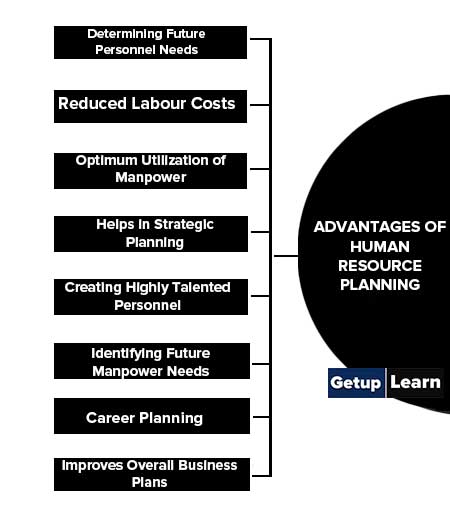
Determining Future Personnel Needs
Planning helps in determining future personnel needs. Surplus or deficiency in staff may be the result of the absence or defective planning. Human Resource Planning helps the management to appoint just the right number of employees with the required skills to avoid wastage of human resources.
Reduced Labour Costs
With the help of Human Resource Planning, the management is able to anticipate shortages or a surplus of manpower. This allows the management to take corrective action on time to restore balance regarding the human resources in the organization. This ensures that labor costs are reduced.
Optimum Utilization of Manpower
Human Resource Planning ensures that the organization is able to effectively utilize the manpower that is present in the organization. The workers are able to work at their maximum potential which leads to the overall development of the employees of the organization.
Helps in Strategic Planning
At every stage, while formulating a strategic plan, Human Resource Planning provides the necessary support. It helps in determining the number of employees and the type of employees required. Further, it also helps in the allocation of resources as well as how workers could be retained. Human resource managers facilitate the process of strategic planning and help in achieving the objectives of the organization.
Creating Highly Talented Personnel
Human Resource plans make the Human Resource policies up to date which makes them attractive to prospective employees as well as current employees. Human Resource Planning helps Human Resource Managers to retain and attract qualified and skilled personnel.
Identifying Future Manpower Needs
Human Resource Planning helps the managers to identify the number as well as the type of employee which is required in the organization. Further, with the help of training, the existing manpower can be developed to fill in future vacancies.
Career Planning
Through Human Resource Planning, the Human Resources manager is able to identify such employees who have good potential to become leaders in the organization. This helps the mgt to retain employees who possess the necessary skills for the organization.
Improves Overall Business Plans
As Human Resource Planning forecasts the number of employees, it helps the management to improve the quality of plans which are formulated by them for achieving the overall objectives of the organization.
Limitations of Human Resource Planning
Even though Human Resource Planning has many advantages there are certain limitations of human resource planning that reduce its usefulness to a certain extent:
- Inaccuracy of Forecasts
- Support of Top Management
- Resistance from Employees
- Forceful Adoption
- Uncertain
- Requires Coordination From All Managers
- Expensive and Time-Consuming
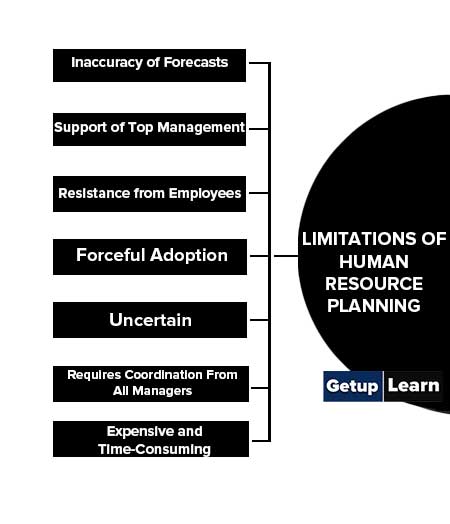
Inaccuracy of Forecasts
Human Resource Planning is an activity that is based on forecasts and estimates. For the success of Human Resource Planning, it is essential that the estimates are accurate. In case they are not accurate, the plans which are drawn on the basis of these estimates would not be able to achieve the desired results.
Support of Top Management
In order to successfully undertake the activity of Human Resource Planning, the support of management is very essential. In absence of their support and commitment, proper allocation of resources is not possible which leads to improper implementation of the plans.
Resistance from Employees
Many times, trade unions oppose the activity of Human Resource Planning as they feel that the overall activity of Human Resource Planning increases their workload. Moreover, they also might feel that the activity of Human Resource Planning highly regulates their bargaining capacity. They also feel that it creates a highly disadvantageous situation for unskilled laborers which might result in them losing their jobs.
Forceful Adoption
It might be possible that the activity of Human Resource Planning is forcefully implemented by the management in order to ensure that they also remain at the same level as their competitors by adopting the same procedures without considering the suitability of such procedures.
As a result, Human Resource Planning instead of delivering the advantages that were expected would create problems for the organization.
Uncertain
As Human Resource Planning is concerned with forecasting aspects related to Human Resources, which themselves are dynamic resources, the estimates which are derived would also be highly uncertain. Due to this, accurate estimates cannot be derived and as a result, Human Resource Planning would not be able to deliver the intended results.
Requires Coordination From All Managers
Human Resource Planning is an activity that should be done in coordination with all other managers. But it might be possible that such coordination is difficult to be achieved. So the level of accuracy which is desired for the purpose of Human Resource Planning might not be achieved.
Expensive and Time-Consuming
Employers consider the activity of Human Resource Planning to be time-consuming and expensive as for undertaking it accurate forecasts are required. For deriving accurate forecasts, the services of experts may have to be availed which are expensive. So, employers are generally not in favor of undertaking Human Resource Planning in their organization.
What is human resource planning with example?
Planning is deciding in advance of the future course of action. It is the process of thinking before doing. It is a very important activity in today’s scenario. Planning as a process involves the determination of the future course of action. In terms of Human resources, planning is a process of forecasting manpower needs, developing appropriate policies and programs for meeting those needs, and controlling these programs.
What is the simple definition of human resources?
Human Resource Planning is the process including forecasting, developing, and controlling by which a firm ensures that it has the right number of people and the right kind of people at the right places at the right time doing work for which they are economically most useful.
What are the needs for human resource planning?
Following are the needs for human resource planning:
1. Helps in Finding Replacement for Persons
2. Reduce Labour Turnover
3. Expansion Plans
4. Technological Changes
5. Assessing Needs.
What are the limitations of human resource planning?
Following are the limitations of human resource planning:
1. Inaccuracy of Forecasts
2. Support of Top Management
3. Resistance from Employees
4. Forceful Adoption
5. Uncertain
6. Requires Coordination From All Managers
7. Expensive and Time-Consuming




